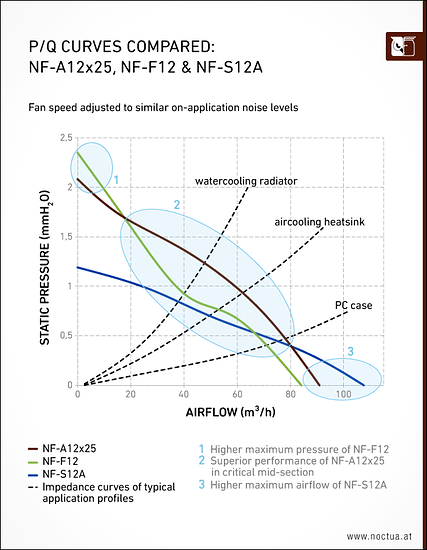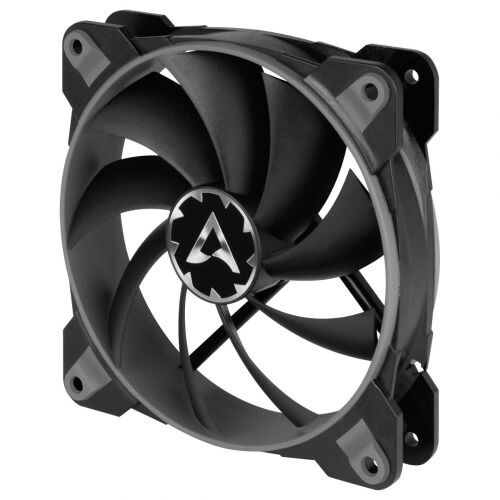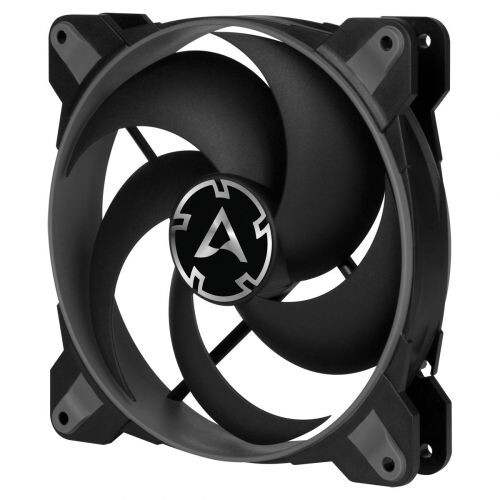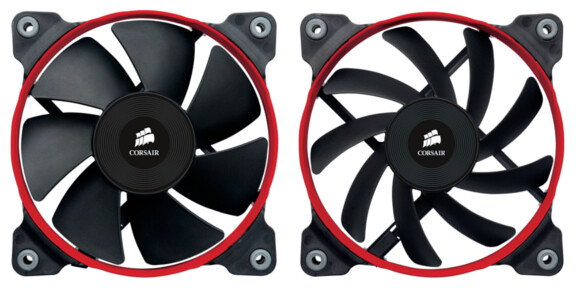So cooling, to me, is one of the more vital factors in my PC builds. I have been a enthusiast of cooling for a long time. I have built over 30 different pc’s or versions of PC’s over the last 3 years.
With cooling being a main focus for me I explored many avenues from AIO (All in One) coolers, air coolers, custom loops and blocks, under volting with a over clock, deliding, and liquid metal applications.
When I’m designing a system I always look at air flow and this always leads to fans!
Fan choices seem simple. Look at the numbers and pick the highest one. If this was the case I would end up with a set of Industrial Noctuas and a Jet engine on my desk. lol
The truth is there are more subtle choices when selecting fans I hope to cover here to help people pick the best fan for them, and their application. There are a lot of people who have a lot of different opinions and feelings on this issue. I hope we can discuss this here to see how others think on the subject as well.
So, with that lets jump in. There are a few things I look at when I consider a fan for my system that relate to fans properties. Here’s the list.
1.) How will this fan be used?
2.) In a free flowing space (IE-case grill with plenty of space around it?)
3.) On the case or in a highly restrictive area (IE-against a HDD tray, radiator or flow restrictive grill intake or exhaust)
4.) Whats more important- Performance or How loud it is?
Below is a sample of some of the 120mm fans I had compared in a chart. I selected all PWM (Pulse Width Modulation- Meaning has 4 pins and a controllable fan speed with compatible hardware). The other type is a 3 pin fan ment to operate at a set speed. Some of these can be controlled by controlling the voltage to the fan in DC mode but the range of the fan operating speed varies from fan to fan. There are a lot more with different specs, but these will help to explain my points.
| Fan Model: | Air Flow (CFM) | Static Pressure (mm H2O) | dB/A | RPM |
|---|---|---|---|---|
| Noctua- | ||||
| NF-A12x25 | 60 (102.1m3/h) | 2.34 | 22.6 | 2000 |
| NF-A12x15 (Thin) | 55 (94.2m3/h) | 1.53 | 23.9 | 1850 |
| NF-P12 redux-1700rpm | 70 (120.2m3/h) | 2.83 | 25.1 | 1700 |
| NF-F12 | 55 (93.4m3/h) | 2.61 | 22.4 | 1500 |
| NF-S12 | 63 (107.5m3/h) | 1.19 | 17.8 | 1200 |
| Corsair- | ||||
| ML-120 Pro | 75 | 4.2 | 37 | 2400 |
| ML120 PRO RGB | 47.3 | 1.78 | 25 | 1600 |
| LL-120 | 63 | 3 | 36 | 2200 |
| SP120 RGB PRO | 52 | 1.45 | 26 | 1400 |
| Air Series™ AF120 | 52 | 1.45 | 26 | 1400 |
| iCUE QL120 | 41.8 | 1.55 | 26 | 1500 |
| Be Quiet! | ||||
| Silent Wings 3 120mm PWM high-speed | 73 (124.58m3/h) | 3.37 | 28.6 | 2200 |
| Pure Wings 2 120mm high-speed | 65 (111.3m3/h) | 2.23 | 35.9 | 2000 |
| Shadow Wings 2 120mm PWM | 38.5 (65m3/h) | 0.82 | 15.9 | 1100 |
| GentleTyphoon 120mm Silent Case Fan Series D1225C12B6ZPA 2150RPM PWM | 68 | 2.9 | 32 | 2150 |
| EK | ||||
| EK-Furious Vardar EVO 120 BB | 107(181m3/h) | 5.81 | 42 | 3000 |
| EK-Vardar X3M 120ER | 67(114m3/h) | 2.75 | 34.2 | 2200 |
So there are the numbers, but lets take a look at the different numbers and what they mean.
1.) Air flow - This is the amount of air the fan moves at MAXIMUM (this will be important later) speed. A common market trick here to make a fan seem to move more air is to use m3/h instead of CFM. m3h is a larger number than CFM numbers as you can see in the conversions above.
2.) Static Pressure - This is the MAXIMUM amount of pressure the fan can produce (more on this in a second)
3.) dB/A - Sound produced by the fan- at maximum speed. This can also be in sone which has to be converted. This is a trick in marketing that if you don’t look too close makes a fan seem much quieter than others if you think you are using the same scale.
4.) RPM - The speed at which the fan turns.
At first glance if you purely want most air flow and static pressure the EK’s are top of the list with 107CFM (181m3/h), 5.81 SP (Static Pressure in mmH2O) but a little loud at 42 dB/A. If you want silence and flow you want Noctua NF-S12 63CFM (107.3m3/h), 1.19 SP at only 17.8 dB/A.
There’s one more thing to consider, something we need a little science and math to get into. The shape of the fan blade makes a huge difference in how a fan performs. The geometry of the blade, material and number of blades all make a difference in air flow, SP, and dB/A. The motor as well effects the dB/A of the fan as well.
There are two basic types of fans that are highly specalized.
The first one is a AF (Air Flow) fan. This can be called a lot of different things, but its focus is to move as much air as possible when there is as little are resistance as possible. There are usually less blades with a more aggressive curve to the blade. Here’s a example Below. You can see when you look at the fan head on there are large gaps to allow air to flow freely. You will notice a difference with the next type of fan. Here is a AF fan from Noctua.
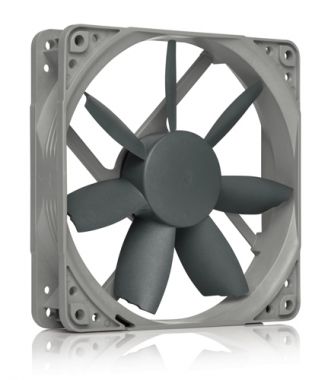
The next type of specialized fan is called a SP (or Static Pressure fan). While they can move a lot of air, the place where these fans shine is moving air through a restrictive area like a radiator or drive bay cage where there is a lot of resistance to air flow. When looking on this fan head on there are more blades and much smaller if any gaps between blades when you look at it head on. Here is an example of a SP fan.
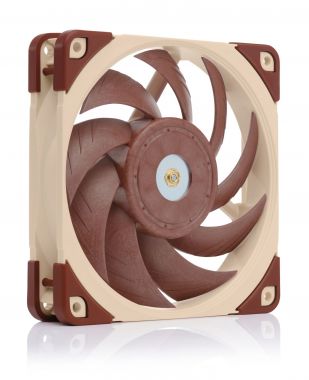
So this is one thing to consider when picking a fan. Will it be a AF or do you need a SP fan?
To complicate this there is another factor to consider that has to do with the above. Air Flow (AF) is at its maximum is at maximum speed…BUT maximum Static Pressure (SP) is NOT at maximum speed it is at a much slower speed. To really see SP compaired to rpm you need to find a graph called a P/Q curve chart. Here is an example from Noctua.
As you can see as AF increases (RPM as well), SP actually drops. That curve is effected by the geometry and style of the fan blade.
So from this we see we want a AF fan that is quiet but moves a lot of air but were not very concerned with SP for case fans with very little restriction. This way we can get maximum flow with the least noise. Yet a lower AF but higher SP fan would be better suited for a radiator application.
The other thing to consider is RPM vs dB/A. Some fans have a much higher dB/A but if you look closer they may have a larger RPM range that may be 500 to 700rpm or more difference. The trouble is different fans have different acoustics. Some are dead silent all the way up to 1200 RPM, some can barely break 600rpm before they are noticeable.
Also, now a lot of fans on the market claim to be one type of fan or the other but they are actually a hybrid type attempting to create both SP and AF.
So while you may see tons of reviews, and claims about fans take a second and really look before you buy something you may not want or need.
Hope this helps some people make more informed choices depending on their needs.
As for my choices…
For my gaming rigs I went with the the Corsair ML-120 Pro’s. These are barely audible at 1200rpm producing both static and airflow. They draw a lot of power and its hard to do more than two on one Corsair commander pro header, but are ok to do 3 off one motherboard header. I choose them because they can produce so much AF if needed when I overclock or if I need to run a CPU intensive task for a long time. I have them tied to water temperature which is great for cutting out spikes in fan speed (this is a whole other issue I can write on if people are interested).
For my server I decided to try the Noctua NF-P12 Redux 1700 PWM. I was really pleased with this fan. Yes it doesn’t have the rubber bumpers like chromax or the standard fans, but I haven’t noticed more noise if mounted securely. They really are quiet and match the specs of the real SP king Noctua’s NF-A12x25. For 2/3rds the price I cant beat it and will use it more more than likely.
I also have some more experiences with different fans but I’ll leave that for another day maybe.
Open to any feedback or thoughts from people. I’m sure there are people much smarter than me here who have done the same considerations I have.
